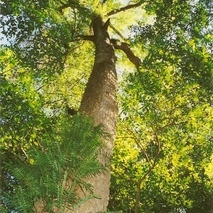A medium sized tree. It grows 20-30 m tall and spreads 5-10 m wide. The trunk is straight. The bark is grey and finely scaly. Young shoots are soft and silky. The leaves are simple. They are arranged opposite one another. The leaves are 7-10 cm long by 1-2 cm wide. The leaves are dark green above and paler underneath. The leaves have coarse teeth around the edge. The leaves have a sarsaparilla like odour when crushed. Flowers are 2-3 cm across and white. They have silky hairs. The flowers are often in groups of 3. The fruit is 0.6-2 cm long and oval. They are brown and split on one side to expose the small fruit inside.


